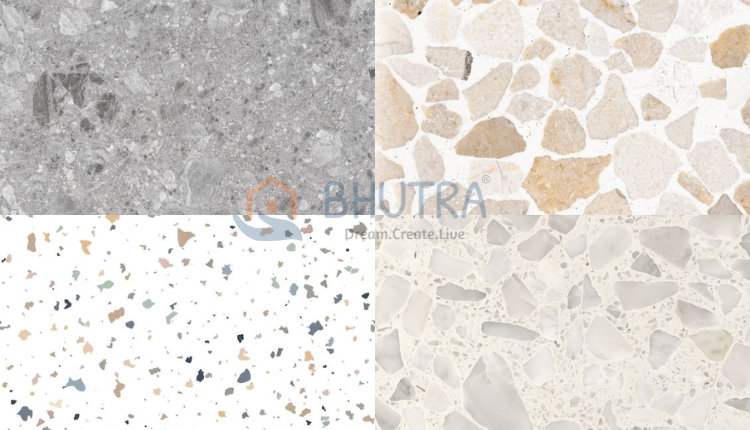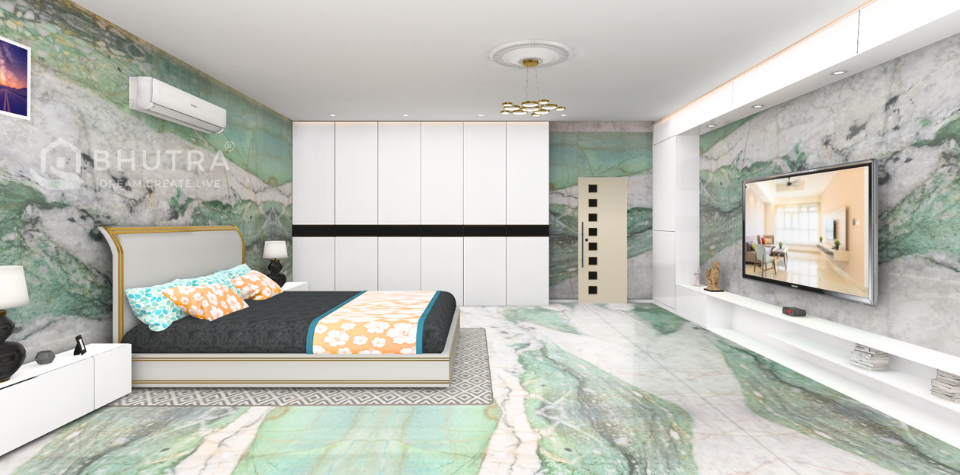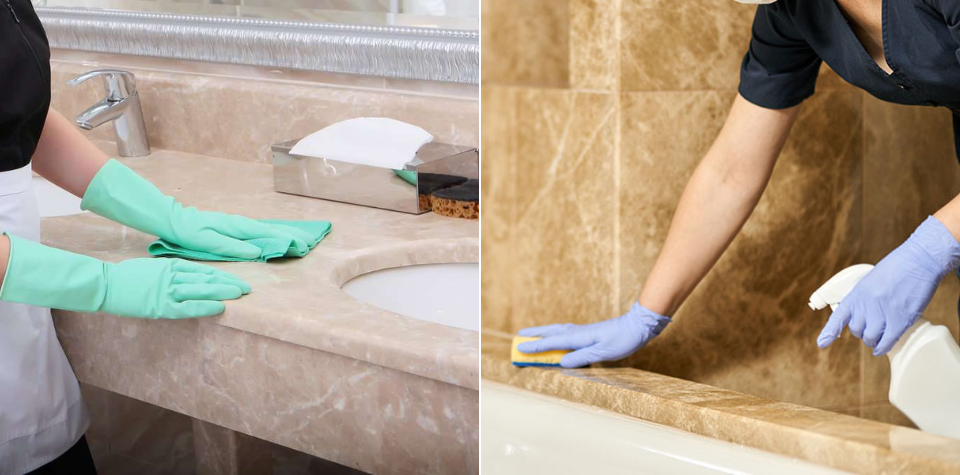Exploring Different Types of Terrazzo Marble

Rajasthan Marble
July 28, 2023
Leather Finish Granite
August 7, 2023Terrazzo marble is an age-old building material that dates back to ancient times.
Its origin can be traced to Venetian construction workers who discovered a creative way to reuse discarded marble chips by embedding them into clay for flooring purposes.
Over time, this technique evolved, and today’s terrazzo marble is a more refined and sophisticated version of its humble beginnings.
History and Origins
The history of terrazzo marble dates back to 15th-century Venice, where it was first used in the construction of terraces around buildings.
As demand grew, terrazzo was used more extensively in cathedrals and palaces, becoming a symbol of luxury and grandeur.
From Italy, the technique spread to other parts of Europe and eventually the world, undergoing various adaptations along the way.
Components of Terrazzo Marble
Terrazzo marble is composed of two primary components: marble chips and a binder. The marble chips can vary in size, shape, and color, providing a wide range of design possibilities.
The binder, whether cement-based or epoxy resin, holds the marble chips together and forms a durable, polished surface.
Marble Chips
The quality and appearance of terrazzo marble heavily depend on the type and quality of marble chips used. While white and gray marble chips are more traditional, modern terrazzo embraces a variety of colors and even incorporates recycled materials like glass.
Binder
The binder in terrazzo marble can be either cement-based or epoxy resin. Cement-based terrazzo is more traditional and offers a classic, natural look, while epoxy resin allows for greater design flexibility and a more seamless finish.
Traditional Terrazzo vs. Modern Terrazzo
Traditional terrazzo often featured a limited color palette, with white, gray, and black being the dominant hues. However, modern terrazzo has broken free from these constraints, allowing for an explosion of colors and patterns, making it a popular choice for contemporary designers.
Terrazzo Installation Process
The installation of terrazzo marble is a multi-step process that requires skilled artisans and precision. Understanding the steps involved can help you appreciate the craftsmanship that goes into each terrazzo installation.
Surface Preparation
Before laying the terrazzo, the surface needs to be properly prepared. This involves cleaning the substrate, ensuring it is level, and creating a solid foundation for the terrazzo to adhere to.
Mixing and Pouring
During this stage, the marble chips are mixed with the chosen binder. The mixture is then poured onto the prepared surface and spread evenly.
Grinding and Polishing
Once the terrazzo has cured, the surface undergoes a grinding process to remove any imperfections and achieve a flat, smooth finish. Polishing follows, enhancing the beauty and luster of the terrazzo.
Types of Terrazzo Marble
Terrazzo marble comes in various types, each offering distinct visual effects and design possibilities.
White Marble Terrazzo
White marble terrazzo exudes elegance and timelessness, making it a popular choice for luxurious interiors and classic designs.
Black Marble Terrazzo
Black marble terrazzo provides a striking contrast and is often used to create bold, contemporary spaces.
Colored Terrazzo
Colored terrazzo opens up a world of creativity, enabling designers to experiment with vibrant hues and patterns to suit any space.
Glass Chip Terrazzo
Glass chip terrazzo incorporates recycled glass, adding a touch of sustainability and sparkle to the design.
Mother-of-Pearl Terrazzo
Mother-of-pearl terrazzo features iridescent shell fragments, adding a touch of opulence and luxury to the surface.
Applications of Terrazzo Marble
The versatility of terrazzo marble makes it suitable for a wide range of applications.
Flooring
Terrazzo flooring is durable, easy to clean, and visually appealing, making it a perfect choice for high-traffic areas.
Countertops and Backsplashes
Terrazzo countertops and backsplashes add a unique touch to kitchens and bathrooms, enhancing the overall aesthetic.
Wall Coverings
Terrazzo wall coverings create stunning feature walls, adding texture and visual interest to any space.
Staircases
Terrazzo staircases make a statement, elevating the design of any building or home.
Decorative Pieces and Art Installations
Terrazzo can be molded into various shapes, allowing for artistic expression and custom installations.
Benefits of Terrazzo Marble
Terrazzo marble offers several advantages that make it a desirable material for both residential and commercial projects.
Durability and Longevity
Terrazzo is highly durable and can withstand heavy foot traffic, making it ideal for long-lasting applications.
Versatility in Design
The wide range of colors, patterns, and aggregates allows for endless design possibilities.
Sustainability and Eco-friendliness
Terrazzo can incorporate recycled materials, contributing to sustainable building practices.
Low Maintenance
With proper care, terrazzo requires minimal maintenance, making it a cost-effective choice in the long run.
Terrazzo Marble in Modern Interior Design Trends
Terrazzo marble has made a strong comeback in modern interior design trends.
Terrazzo Revival
The revival of terrazzo celebrates its history while embracing contemporary aesthetics.
Terrazzo with Bold Colors and Patterns
Designers are not afraid to experiment with vibrant colors and intricate patterns in terrazzo applications.
Terrazzo in Minimalist Designs
Terrazzo’s versatility allows it to complement minimalist designs, adding subtle texture and character.
Cleaning and Maintenance of Terrazzo Marble
To keep terrazzo marble looking its best, regular cleaning and proper maintenance are essential.
Terrazzo Marble: Price and Cost Considerations
The cost of terrazzo marble can vary depending on the type of marble used, installation complexity, and project size.
Exploring Terrazzo Marble Around the World
Terrazzo marble can be found in iconic buildings around the world, showcasing its timeless beauty and endurance.
Terrazzo in Italian Architecture
Italy, the birthplace of terrazzo, boasts numerous historical buildings adorned with this magnificent material.
Terrazzo in Middle Eastern Palaces
Terrazzo marble has been a staple in the grand palaces of the Middle East, adding a touch of luxury to opulent interiors.
Terrazzo in Modern American Buildings
Terrazzo continues to be embraced by contemporary American architects for its versatility and allure.
Conclusion
Terrazzo marble is a captivating material that has stood the test of time, combining beauty and durability in one package.
From traditional white and gray terrazzo to vibrant colored variations, the design possibilities are endless.
Whether used for flooring, countertops, or artistic installations, terrazzo marble continues to play a significant role in modern interior design.
FAQs
Q.1: Is terrazzo marble suitable for outdoor use?
A: Terrazzo marble is primarily used for indoor applications due to its sensitivity to harsh weather conditions.
Q.2: Can I install terrazzo marble myself?
Terrazzo marble installation requires specialized skills and equipment, so it’s best left to professional craftsmen.
Q.3: Does terrazzo require regular sealing?
Depending on the type of binder used, some terrazzo may require periodic sealing to maintain its appearance.
Q.4: Is terrazzo a sustainable building material?
Yes, terrazzo can be eco-friendly when incorporating recycled materials into the mix.
Q.5: What is the typical lifespan of terrazzo flooring?
With proper maintenance, terrazzo flooring can last several decades, making it a long-term investment for any space.





